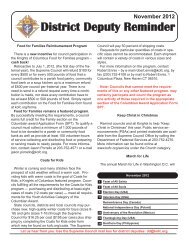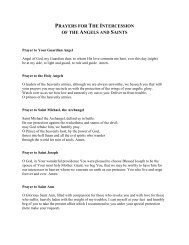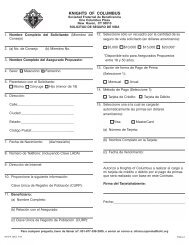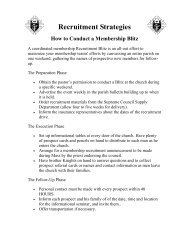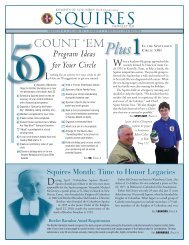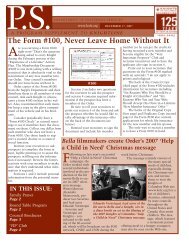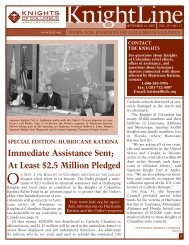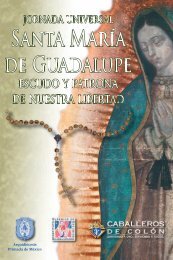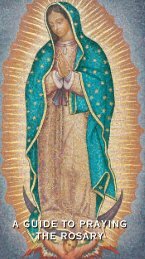CATHOLIC WORD BOOK - Knights of Columbus, Supreme Council
CATHOLIC WORD BOOK - Knights of Columbus, Supreme Council
CATHOLIC WORD BOOK - Knights of Columbus, Supreme Council
Create successful ePaper yourself
Turn your PDF publications into a flip-book with our unique Google optimized e-Paper software.
their part, have not yet arrived at an<br />
explicit knowledge <strong>of</strong> God, but who strive<br />
to live a good life, thanks to his grace.<br />
Whatever good or truth is found among<br />
them is looked upon by the Church as a<br />
preparation for the Gospel. She regards<br />
such qualities as given by him who<br />
enlightens all men so that they may finally<br />
have life” (Dogmatic Constitution on the<br />
Church, Lumen Gentium, No. 16).<br />
Sanctifying Grace: See Grace.<br />
Satanism: Worship <strong>of</strong> the devil, a<br />
blasphemous inversion <strong>of</strong> the order <strong>of</strong><br />
worship which is due to God alone.<br />
Scandal: Conduct which is the occasion <strong>of</strong><br />
sin to another person.<br />
Scapular: (1) A part <strong>of</strong> the habit <strong>of</strong> some<br />
religious orders like the Benedictines and<br />
Dominicans; a nearly shoulder wide strip<br />
<strong>of</strong> cloth worn over the tunic and reaching<br />
almost to the feet in front and behind.<br />
Originally a kind <strong>of</strong> apron, it came to<br />
symbolize the cross and yoke <strong>of</strong> Christ. (2)<br />
Scapulars worn by lay persons as a sign <strong>of</strong><br />
association with religious orders and for<br />
devotional purposes are an adaptation <strong>of</strong><br />
monastic scapulars. Approved by the<br />
Church as sacramentals, they consist <strong>of</strong><br />
two small squares <strong>of</strong> woolen cloth joined<br />
by strings and are worn about the neck.<br />
They are given for wearing in a ceremony<br />
<strong>of</strong> investiture or enrollment. There are<br />
nearly 20 scapulars for devotional use: the<br />
five principal ones are generally<br />
understood to include those <strong>of</strong> Our Lady <strong>of</strong><br />
Mt. Carmel (the brown Carmelite<br />
Scapular), the Holy Trinity, Our Lady <strong>of</strong><br />
the Seven Dolors, the Passion, the<br />
Immaculate Conception.<br />
-62-<br />
Scapular Medal: A medallion with a<br />
representation <strong>of</strong> the Sacred Heart on one<br />
side and <strong>of</strong> the Blessed Virgin Mary on the<br />
other. Authorized by St. Pius X in 1910, it<br />
may be worn or carried in place <strong>of</strong> a<br />
scapular by persons already invested with a<br />
scapular.<br />
Scapular Promise: According to a legend<br />
<strong>of</strong> the Carmelite Order, the Blessed Virgin<br />
Mary appeared to St. Simon Stock in 1251<br />
at Cambridge, England, and declared that<br />
wearers <strong>of</strong> the brown Carmelite Scapular<br />
would be the beneficiaries <strong>of</strong> her special<br />
intercession. The scapular tradition has<br />
never been the subject <strong>of</strong> <strong>of</strong>ficial decision<br />
by the Church. Essentially, it expresses<br />
belief in the intercession <strong>of</strong> Mary and the<br />
efficacy <strong>of</strong> sacramentals in the context <strong>of</strong><br />
truly Christian life.<br />
Schism: Derived from a Greek word<br />
meaning separation, the term designates<br />
formal and obstinate refusal by a baptized<br />
Catholic, called a schismatic, to be in<br />
communion with the pope and the<br />
Church. The canonical penalty is<br />
excommunication. One <strong>of</strong> the most<br />
disastrous schisms in history resulted in<br />
the definitive separation <strong>of</strong> the Church in<br />
the East from union with Rome about<br />
1054.<br />
Scholasticism: The term usually applied to<br />
the Catholic theology and philosophy<br />
which developed in the Middle Ages. (See<br />
also Neo-Scholasticism.)<br />
Scribes: Hebrew intellectuals noted for<br />
their knowledge <strong>of</strong> the Law <strong>of</strong> Moses,<br />
influential from the time <strong>of</strong> the Exile to<br />
about A.D. 70. Many <strong>of</strong> them were<br />
Pharisees. They were the antecedents <strong>of</strong>




